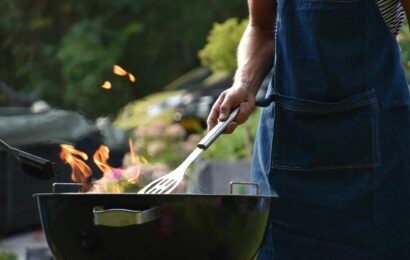There is no experience more frustrating than cutting vegetables and meat with a dull knife. Knives are an essential tool in almost any cooking project, and the last thing a chef when preparing a meal is to battle against his or her ingredients when attaining a certain size and shape. Learning how to sharpen a knife is an indispensable skill no matter what meals you are accustomed to preparing because knives are used at some point in the vast majority of recipes. Ensuring that your knife is sharp will make every cooking project safer, faster and more enjoyable.Many people only have the time to cook meals after a long day at work when they are already exhausted from exerting themselves mentally and emotionally. Since they begin cooking in this state, people often search for recipes that are fast and low-effort in an attempt to get closer to an evening of relaxation. However, no recipe is easy or low-effort if it is cooked without efficient kitchen tools, such as sharp knives. By learning how to sharpen a knife, you are setting your future self up for a quicker, more enjoyable cooking experience.
The Importance of Keeping Your Knives Sharp
There are multiple reasons for perfecting the skill of knife sharpening, but one of the most important motivations is safety. A dull knife is an accident waiting to happen because it is more likely to slip off of the food and onto your fingers. Dull knives also require more pressure to cut food, so if they slip, they are likely to do substantial damage to a finger or hand. Learning how to sharpen a knife is crucial to ensuring that your kitchen is a safe environment.
Along with safety, sharp knives are important when following precise recipes that call for exact shapes and sizes of ingredients. Food that has not been cut well will not cook properly because oven temperatures are selected with a certain size in mind. If a chef dices vegetables in pieces that are larger than the recipe’s requirements, there is a high chance that they will need more time than the recipe calls for to be completely cooked. This can negatively affect texture and flavor, causing the recipe to be less predictable than chefs typically prefer.Keeping your knives sharp is also essential if you hope to cook efficiently because dull knives can cause the process of chopping to be much more difficult. Especially when chopping foods that are large and hard, such as potatoes, a dull knife can extend the chopping process to an unreasonable amount of time. Since many people cook at the end of a long day or when they are already hungry, a sharp, efficient knife is highly preferable in comparison to a dull one.
How to Sharpen a Knife

Image via: Pixabay
There are multiple reasons for perfecting the skill of knife sharpening, but one of the most important motivations is safety. A dull knife is an accident waiting to happen because it is more likely to slip off of the food and onto your fingers. Dull knives also require more pressure to cut food, so if they slip, they are likely to do substantial damage to a finger or hand. Learning how to sharpen a knife is crucial to ensuring that your kitchen is a safe environment.
Along with safety, sharp knives are important when following precise recipes that call for exact shapes and sizes of ingredients. Food that has not been cut well will not cook properly because oven temperatures are selected with a certain size in mind. If a chef dices vegetables in pieces that are larger than the recipe’s requirements, there is a high chance that they will need more time than the recipe calls for to be completely cooked. This can negatively affect texture and flavor, causing the recipe to be less predictable than chefs typically prefer.Keeping your knives sharp is also essential if you hope to cook efficiently because dull knives can cause the process of chopping to be much more difficult. Especially when chopping foods that are large and hard, such as potatoes, a dull knife can extend the chopping process to an unreasonable amount of time. Since many people cook at the end of a long day or when they are already hungry, a sharp, efficient knife is highly preferable in comparison to a dull one.
Honing a Knife

Image via: Pixabay
Honing a knife is similar to sharpening one, but the aim of honing is to straighten out the knife’s blade rather than truly changing its level of sharpness. We advise you to hone your knives often to maintain a straight edge which will help your knives to feel sharper and more efficient. You can hone a knife using knife-sharpening steel, which is the piece of metal that typically comes with a set of knives. To use knife-sharpening steel, hold it vertically with its tip on the counter.Pointing the tip of the knife downward, place the blade’s heel against the tip of the steel, at about a 15-degree angle from the steel. Maintain this angle and move the blade down the steel in a fluid motion, pushing down with a slight amount of pressure. As you do so, bring the knife toward your body, ensuring that the middle of the blade is touching the middle of the steel. To complete the honing process, move the blade’s tip over the bottom of the steel, repeating this on both sides of the blade until the edge is completely straight.You should hone a knife if it is slightly dull or if its edge is slightly out of shape. However, if your knife is very dull, you need more than a sharpening steel to bring it back to peak condition; you need to learn how to sharpen a knife. Your options for sharpening a knife are to utilize a whetstone, use an electrical or manual sharpener, or bring it to a professional knife sharpener. To decide which of these options is best for you, it is recommended to research each method and evaluate whether it is a viable option.
Electric Knife Sharpener

Image via: Pixabay
Since whetstones can be intimidating when an inexperienced knife owner is learning how to sharpen a knife, many people resort to electric knife sharpeners when their knives become dull. These machines are easy to understand, but we advise you to pay close attention to the instructions in the machine’s manual. Electric knife sharpeners have abrasive motorized wheels that move against the blade of the knife. To use them, turn the machine on, place your knife gently but firmly on the wheels, and pull the blade along the slots slowly and fluidly.Sharpen both sides of your blade, switching sides every few strokes. Some electric knife sharpeners have a number of slots for varying levels of dullness, so pay attention to which slots are designated to heavy damage and which are created for minimal sharpening. Another option that is similar to the electric knife sharpener is the manual sharpener which has non-motorized wheels instead. This may take longer, but the idea is the same- pull the knife through the slots with light but firm pressure until the knife is a desirable level of sharpness.
Whetstones

Image via: Pixabay
One of the most popular options for sharpening a knife is to use a whetstone, a fine-grained stone used for sharpening cutting tools. To use a whetstone, you must first place the stone on the countertop coarse side up. To ensure that it is secure, place damp paper towels or a shelf liner beneath the stone, which will keep it from moving throughout the process. Place the handle end of your knife on the whetstone, facing the sharp edge away from your body.The angle of the blade to the whetstone should be 15 to 20 degrees. Use the hand that you are not holding the knife with to place in the middle of the blade along its flat side, taking care to keep your fingers far from the sharp edge. Move the blade along the stone in a circular shape, keeping the knife at its original angle until its tip runs off the other edge of the stone. Continue this motion until the blade is significantly sharper.It is now important to check the sharpness of the blade by moving your thumb gently along the blade’s edge, keeping it perpendicular to the knife. If you can feel the burr from the tip to the handle of the knife, you know that it is adequately sharpened. Once you have ascertained this, repeat the process of moving the blade along the whetstone, but in the opposite direction. Finally, repeat the process on both sides of the blade using the fine side of the whetstone until the blade is perfectly sharp.
What to Avoid When Sharpening Knives
There are a few basic mistakes to avoid when sharpening knives, but the most common miscalculation is to use too much pressure when holding the blade. It is essential to keep the knife steady and press down gently, but remember that the machine or stone you use will do most of the work. Along with this, it is important to make multiple strokes on each side of the knife before switching sides. The best way to get a perfectly sharp edge is to do multiple strokes on one side, no less than five, and then repeat the process on the other side.
Conclusion
There are a few basic mistakes to avoid when sharpening knives, but the most common miscalculation is to use too much pressure when holding the blade. It is essential to keep the knife steady and press down gently, but remember that the machine or stone you use will do most of the work. Along with this, it is important to make multiple strokes on each side of the knife before switching sides. The best way to get a perfectly sharp edge is to do multiple strokes on one side, no less than five, and then repeat the process on the other side.












